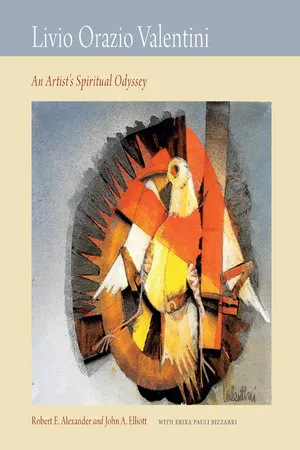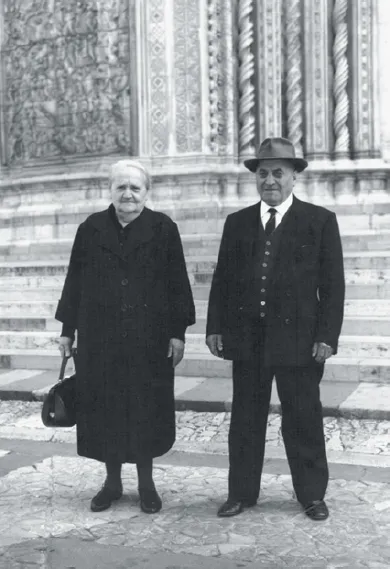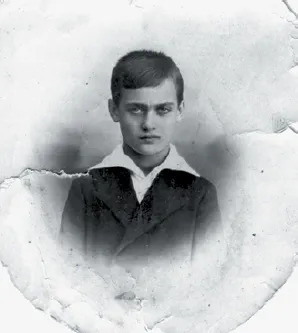![]()
CHAPTER ONE
Livio’s Early Life
LIVIO WAS BORN INTO A WORLD of great uncertainty and political upheaval, shaped by war. His earliest years followed the end of the “Great War,” World War I. Like the rest of Europe, Italy was reeling from high unemployment, large-scale strikes in the major factories, political unrest, and social convulsions. Even though Italy had fought on the winning side, the results were bittersweet. France and England had promised significant rewards, including major portions of the Ottoman Empire, for Italy’s participation. While Italy did gain additional territory at the conclusion of the war, it was not nearly as much as had been promised. This major disappointment and the general economic conditions set the stage for Mussolini and his Fascist Party to convert Italy from a democratic monarchy to a totalitarian state. In general, people were open to Mussolini’s promises of a better life and the creation of a new Roman Empire.
As a result of hyperinflation, unemployment, and social unrest in the early 1920s, many rural families were forced to relocate in an effort to find steady jobs and safe accommodations. The large estates could no longer afford the number of workers who had been required to operate these properties in the recent past. Additionally the owners were under political pressure to restructure and redistribute their lands. There was a struggle between communism and fascism for the soul of Italy. Life had become more difficult for the Italians who lived in small towns and rural areas.1
Livio’s family experiences were typical of so many other rural Italians. He liked to tell how he was “born poor and curious. I was born on the 24th of December, so I disturbed my mother on Christmas day. I disturbed her but she was happy.”2 He was born in San Venanzo, a small mountain village in the Umbrian region of Italy just a few kilometers from Orvieto. Livio’s parents lived and worked on the estate of Count Claudio Faina. Their entire youth revolved around the small town and culture of this estate. They played together, worked together, grew up together, and were married in 1919 on the estate. The family lived in a small cottage, number fifteen, just beyond the manor house. They were an attractive young couple who lived a simple country life. Their first son, Livio, was born on the property and the family lived there until he was two years old.
Livio’s parents, Erminia Pacelli and Alvise Valentini. Photograph courtesy of the Valentini family.
Livio’s mother, Erminia Pacelli (1893–1976), was the first of nine children. During her childhood years she worked in Count Faina’s bakery with her parents. She had one of the most demanding jobs a young person on the estate could have. Bread and pasta were the staples for all Italian families. She was required to wake up before dawn and assist with preparations for baking. She began with the lievito madre (mother starter) that was kept from week to week and renewed each time. Bread was eaten with every meal while pasta was served at the midday and evening meals. In the bakery they made huge rough loaves of country bread with dark dough and a hard crust. She helped make a variety of pastas including umbricelli, a favorite in the Umbrian region. Bread was made daily because no preservatives were used.
In addition to her work in the bakery, she also played a major role in the care of her younger brothers and sisters. Until she was married, Erminia acted as a surrogate mother for her siblings. She was partially deaf as a result of an untreated childhood ear infection. This malady influenced her interactions for the remainder of her life.
Livio’s father, Alvise Valentini (1890–1975), worked part-time on a seasonal basis at the count’s estate. He labored in the fields helping to plant and harvest crops. He was a man of few words unless he had a story to tell and a man for whom the culture of food was important. He had an unusual aptitude for working with his hands and this skill would serve him well later in life. In pursuit of a better future and more secure life for his wife and son, he moved the family to Orvieto in 1922. Alvise’s strength and practical intelligence won him a job with the railroad company. Over the years he worked his way up to become a train engineer. “Father drove a marvelous machine, a train. The train made a lot of smoke and Father was proud of that train. It was as if he owned it.”
After they moved, Livio’s mother no longer worked. He recalled, “Mother had plenty to do at home with me and my brother.” His brother, Piero, was born in 1925, a sickly child who required much attention. Because of these health issues Piero became the major focus of Erminia’s attention. While she doted on her second son, Livio was forced to become more self-sufficient. In some of his earliest photographs, he appears as a serious, dark-eyed boy, mature beyond his years. Although close, Livio and his brother seemed to live in completely different worlds.3
Livio at ten years old. Photograph courtesy of the Valentini family.
The transition from San Venanzo to Orvieto was a significant moment in Livio’s early life. Most of his extended family remained behind in the village. He and his parents started their lives from scratch making new friends and learning to navigate their way around the town and its social structure. They were alone in this strange and new community. Livio remembered these early years of relocation and adjustment as a stressful time in the family’s life.
Livio went to elementary school in Orvieto and felt he did not fit in easily with his fellow classmates. During our interview with him in his Orvieto living room, Livio indicated he did poorly in the more quantitative subjects like mathematics and science. He said he was distracted by his interest in drawing. Since he frequently had to repeat classes, he found himself surrounded by younger students, which became awkward and made school even less appealing. During this interview, Flora, always his advocate, said she would like to check the archives in the school to see why Livio was not promoted. She was convinced he had not been treated fairly.4
Livio’s class in 1930 with art professor Nello Benini. Photograph courtesy of the Valentini family.
Art became Livio’s alternative path. As a child, he was fascinated by drawing but could not afford private art lessons and had to “make do with the advice of his teacher.” One of his earliest teachers, Maestro Nello Benini (1895–1958), did appreciate his artistic talent. Benini was also an etcher, painter, and illustrator of books.5 He encouraged the boy to draw by telling him, “Livio, you draw good grapes.” This was one of Livio’s first affirmations related to his life’s vocation. Because he came from a family of modest means, during Livio’s formative years in painting, with only the encouragement of Benini, he was largely self-taught. When speaking to a group of young students in Aiken, Livio told the following tale:
When I was a schoolboy my teacher, Maestro Benini, sent me to the blackboard and said “draw me a bunch of grapes.” So I went to the huge blackboard and I made a little round thing for a grape. One of my classmates said “those are not grapes. Italian grapes are big.” And so I drew huge grapes. Behold, the teacher pointed to me and said “that is how grapes are made!” So I already understood from my teacher to use my inner eye … and that a grape had an interior part and a surface part. Even in grammar school I understood intuitively that grapes were not just little tiny dots but rather they contained something, the pulp or meat. Grapes have this skin, this envelope around them. I knew it instinctively.6
Livio’s fellow students thought he was a little strange. He was so committed to his art that he would often use money he had been given for chocolate to buy paints and brushes. Some of the older boys in school nicknamed him “Pittò,” the diminutive of Pittore (painter). This was picked up by some of the village curmudgeons since even as a child Livio said that he wanted to be a painter when he grew up. He remembered playing with his friends in the streets and people calling out to him, “What are you going to paint today, Pittò?” When he was in his teens he felt the nickname was rather derogatory. Since money was scarce he took on all kinds of odd jobs so he could buy painting supplies. At the age of fifteen, he started working as an apprentice in the carpentry workshop of the Michelangeli family in Orvieto. Most of his teenage years were spent in this apprenticeship, refining his aesthetic skills and developing designs appealing to the modern eye. His work there would lead to one of his closest friendships and a life of collaboration with Gualverio Michelangeli. While Livio’s parents did not understand his drive to become an artist, they certainly approved of his apprenticeship. It was not until he was eighteen that Livio painted his first canvas. When relatives in San Venanzo, to whom he had given some of his landscapes, praised his work, he said it made him feel like he was becoming a real artist.7
When Mussolini assumed total power in 1922, he invaded much of northern Africa and established an Italian empire; hyperinflation was running rampant throughout all of Europe and Hitler and the Nazis controlled Germany. The political environment changed and by the mid-thirties Mussolini defied the League of Nations and expanded Italy’s empire. Under his leadership Italy moved into an alliance with Germany. The Second World War began in 1939 as Germany conquered much of Europe and Italy was quickly drawn into the war, much to the chagrin of most of its population.8
Life quickly changed for Livio and many of his young friends as they were swept into the vortex of war. At twenty, in April of 1940, Livio was called up by the Italian army to serve in the infantry in Sicily. Livio felt that his poverty determined where he was assigned. He explained, “Those who came from poor families were sent to Sicily; those who came from rich families went to Viterbo.” He was in Sicily for approximately eight months for basic training. He was shipped with his battalion to Albania in October of that year and soon found himself in combat. He was actively engaged in heavy fighting in Albania and Greece from 1940 into early 1943. When the Italians signed a peace treaty with the Allied Forces, his army battalion refused the demands of the Nazis to join in and continue the fight with Germany. A great debate raged throughout Italy as to whether they should sue for peace. Finally a treaty was signed and in July of 1943 Mussolini was removed from power and the German forces initiated a plan to disarm the Italian army and implement an occupation. The refusal of Livio’s unit to fight with and for the Germans placed them in great peril. Several days before, on the Greek isle of Kefalonia, more than five thousand Italian troops had been slaughtered when they refused to fight for the Germans.9
Livio in his military uniform, a photograph taken for his mother. Photograph courtesy of the Valentini family.
This act of defiance resulted in Livio’s battalion being confined as prisoners of war from 1943 to 1945. Imprisoned for several months in Buchenwald, Livio and his fellow soldiers experienced the worst of the inhumanities people inflict on one another. He was transferred to Spandau and then to an area between Munich and Innsbruck. His final days in prison were in Berlin. During his time in the concentration camps he watched some of his closest friends die in front of Nazi firing squads. Only he and one other young man from Orvieto survived the “extermination camps,” as Livio referred to these prisons.10
At the end of the war, Livio returned to Orvieto after escaping his imprisonment and traveling a tortuous and lonely journey through Germany and northern Italy where his life was frequently threatened. He faced the dangers of a population divided by the events of the war and the continuing struggles between the fascists and partisans, those suspected of supporting the Resistance. Skirmishes continued for several years after the war concluded, resulting in deeper schisms of the body politic. For years to come he would be haunted by these experiences just as Italy was torn by the struggle between the various political factions fighting for its soul.
At the end of the war he emerged from the camp weighing only sixty-five pounds. When he finally arrived home, just a skeleton of his former self, his mother and father were very concerned about his health and wellbeing. Even though food was scarce and rationing was still in effect, Erminia tried to fatten him up by cooking all of his favorite foods only to have Livio refuse to eat. He spent much of his time trying to learn how to live in the absence of war. Frequently he retreated to the countryside in an effort to shake the haunting memories of the death camps. He found comfort in returning to his earliest roots and visiting his relatives in San Venanzo.
Livio recalled:
In the first few months, once I came back to normal life, I made a list of things I wanted to get rid of from my life. First, it’s not necessary to eat. I’m talking about the meaning of nourishment itself. It’s not necessary to exaggerate. I was trying to tell myself that I was not going to die of starvation. Other things can happen because you stop eating which are worse than s...




